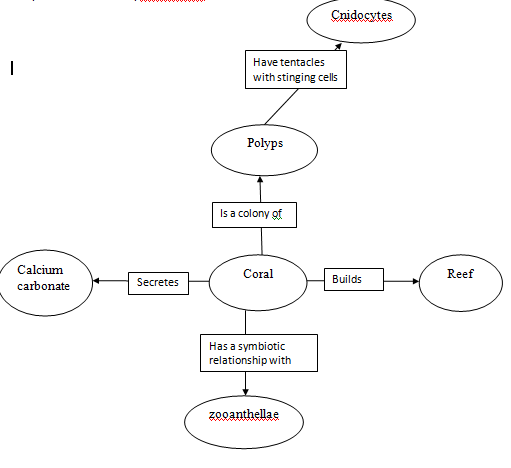
Concept explainers
To make:
A concept map using the given words: coral, polyp, cnidocyte, reef, calcium carbonate, zooanthellae.
Introduction:
There are four main classes of Cnidarians: Hydrozoa, the hydroids; two classes of jellyfishes; and Anthozoa, the sea anemones and corals. Cnidarians display a variety of colors, shapes and sizes. Most of them have two distinct body forms during their life cycles; the polyp stage and the medusa stage.
Answer to Problem 35A
The following concept map depicts the relation between given words; coral, polyp, cnidocyte, reef, calcium carbonate, zooanthellae.

Explanation of Solution
Anthozoans are cnidarians that exhibit only the polyp form.
Corals are anthozoans that live in colonies of polyps in warm ocean waters. They secrete protective, cup like calcium carbonate shelters around their soft bodies. Colonies of many coral species build the beautiful coral reefs that provide food and shelter to many other marine species. Corals that form reefs are called hard corals. When a coral polyp dies, its shelter is left behind, which adds to the coral reef’s structure. Coral reefs are formed very slowly.
A coral polyp extends its tentacles to feed. The tentacles are armed with stinging cells called cnidocytes. Cnidocytes contain nematocysts. Stinging cells that contain nematocysts are discharged from tentacles when prey touches them.
Corals also maintain symbiotic relationship with microscopic, photosynthetic protists called zooanthellae. The zooanthellae provide food and oxygen to corals and use carbondioxide and waste materials produced by corals. These zooanthellae provide beautiful colors to coral reefs.
When the zooanthellae leave, the corals die.
Chapter 24 Solutions
Biology Illinois Edition (Glencoe Science)
Additional Science Textbook Solutions
Anatomy & Physiology
Concepts of Genetics (12th Edition)
Study Guide for Campbell Biology
Microbiology: An Introduction
Concepts of Genetics (11th Edition)
Fundamentals of Anatomy & Physiology (11th Edition)
 Human Anatomy & Physiology (11th Edition)BiologyISBN:9780134580999Author:Elaine N. Marieb, Katja N. HoehnPublisher:PEARSON
Human Anatomy & Physiology (11th Edition)BiologyISBN:9780134580999Author:Elaine N. Marieb, Katja N. HoehnPublisher:PEARSON Biology 2eBiologyISBN:9781947172517Author:Matthew Douglas, Jung Choi, Mary Ann ClarkPublisher:OpenStax
Biology 2eBiologyISBN:9781947172517Author:Matthew Douglas, Jung Choi, Mary Ann ClarkPublisher:OpenStax Anatomy & PhysiologyBiologyISBN:9781259398629Author:McKinley, Michael P., O'loughlin, Valerie Dean, Bidle, Theresa StouterPublisher:Mcgraw Hill Education,
Anatomy & PhysiologyBiologyISBN:9781259398629Author:McKinley, Michael P., O'loughlin, Valerie Dean, Bidle, Theresa StouterPublisher:Mcgraw Hill Education, Molecular Biology of the Cell (Sixth Edition)BiologyISBN:9780815344322Author:Bruce Alberts, Alexander D. Johnson, Julian Lewis, David Morgan, Martin Raff, Keith Roberts, Peter WalterPublisher:W. W. Norton & Company
Molecular Biology of the Cell (Sixth Edition)BiologyISBN:9780815344322Author:Bruce Alberts, Alexander D. Johnson, Julian Lewis, David Morgan, Martin Raff, Keith Roberts, Peter WalterPublisher:W. W. Norton & Company Laboratory Manual For Human Anatomy & PhysiologyBiologyISBN:9781260159363Author:Martin, Terry R., Prentice-craver, CynthiaPublisher:McGraw-Hill Publishing Co.
Laboratory Manual For Human Anatomy & PhysiologyBiologyISBN:9781260159363Author:Martin, Terry R., Prentice-craver, CynthiaPublisher:McGraw-Hill Publishing Co. Inquiry Into Life (16th Edition)BiologyISBN:9781260231700Author:Sylvia S. Mader, Michael WindelspechtPublisher:McGraw Hill Education
Inquiry Into Life (16th Edition)BiologyISBN:9781260231700Author:Sylvia S. Mader, Michael WindelspechtPublisher:McGraw Hill Education





